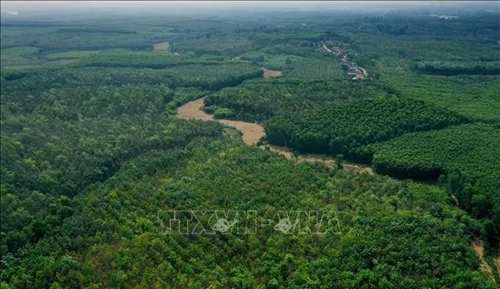The Government assigned the Ministry of Finance to develop a legal framework for financial activities on the carbon market to ensure legal validity and stability in trading activities based on the provisions of the Law on Environmental Protection. This is an important step towards creating a transparent business environment and encouraging businesses to participate.
    |
 |
|
A forest in Gio Linh district, Quang Tri province |
With its diversity, ranging from livestock, crop cultivation, and forestry, Vietnam’s agriculture sector has great potential to shift towards low-carbon emission production. Circular, ecological, and organic farming solutions not only help reduce impacts on the environment but also create valuable carbon credits.
In particular, with over 14 million hectares of forests, the forestry sector plays a crucial role in mitigating emissions and adapting to climate change. It presents a significant advantage due to its ability to achieve negative net emissions through the forests' ability for carbon absorption.
The transferable emission reduction program from the North-Central provinces has been implemented successfully, transferring 10.3 million tons of CO2 and generating USD 51.5 million during the 2018-2019 period. This is a successful model, opening up great prospects for the development of the forest carbon credit market.
The Ministry of Agriculture and Rural Development (now the Ministry of Agriculture and Environment) has signed a Letter of Intent with the Emergent Forest Finance Accelerator (Emergent) organization – the trustee agency of the Lowering Emissions by Accelerating Forest Finance (LEAF) Coalition regarding the transfer of greenhouse gas (GHG) emission reductions.
Accordingly, Vietnam will transfer the GHG absorption (CO2) from 4.26 million hectares of forests in the central and Central Highlands regions to LEAF during the 2022-2026 period in exchange for financial resources to invest in forest protection and development. Vietnam will use up to 100% of the total emission reduction transfer to fulfill its commitments under the Paris Agreement and its Nationally Determined Contribution (NDC).
According to Pham Hong Luong, Deputy Director of the Forestry and Forest Ranger Department, the forest carbon credit market boasts the potential to generate significant revenue, promote forest protection and development, and create jobs for local communities.
Livestock farming has also had a biogas program, which was internationally recognized for its contribution to reducing GHG emissions. Through this program, Vietnam sold 3,072,265 carbon credits, earning USD 8.1 million. It benefited 1 million people in 53 provinces and cities nationwide by supporting the construction of biogas facilities at households, aiming to reduce GHG emissions in production and livestock farming.
The Vietnamese rice sector is also actively preparing to participate in the carbon market. Le Thanh Tung, Vice President and General Secretary of the Vietnam Rice Industry Association (VIETRISA), stated that the association aims to develop a "green rice" brand with low emissions in 2025 and build a label for low-carbon rice, setting a premise for selling carbon credits in 2028.
To Xuan Phuc, Managing Director of Forest Trends' Forest Policy, Trade, and Finance Initiative, stated that domestic and international investors are paying special attention to forestry carbon projects, however, the Government has yet to introduce specific policies guiding this type of investment.
The Government should consider issuing policy mechanisms to activate forestry carbon projects, meeting both mandatory and voluntary market demands, he said.
Source: VNA